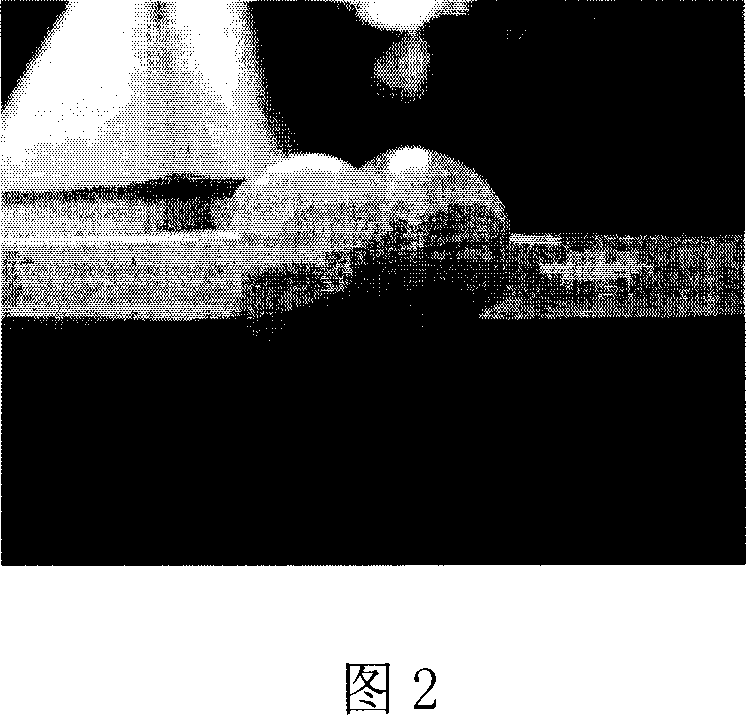Prepn process of nanometer composite aquogel with fast temperature response
A temperature-responsive, nano-composite technology, applied in the field of rapid temperature-responsive nanocomposite hydrogel preparation, can solve problems such as low strength, fragility, and poor mechanical properties, and achieve fast response rate, simple preparation process, and good mechanical properties Effect
- Summary
- Abstract
- Description
- Claims
- Application Information
AI Technical Summary
Problems solved by technology
Method used
Image
Examples
Embodiment 1
[0023] Dissolve 1 g of monomer NIPA and 0.198 g of inorganic clay Laponite in 8 ml of deionized water, blow nitrogen, and stir for 60 minutes, then add 0.2 g of sodium carbonate, blow nitrogen, and stir for 10 minutes. Then add 0.01 g of ammonium persulfate and 8 μL catalyst N, N, N', N'-tetramethylethylenediamine, mix well and continue to pass nitrogen for 5 minutes, then quickly pour it into a test tube with a diameter of 18 mm, seal and place After reacting in a water bath at 20°C for 20 hours, the reactants were taken out and cut into sections, immersed in 0.1mol / L hydrochloric acid solution for 2 days, and the hydrochloric acid solution was replaced every 8 hours. Soak in deionized water for 2 days and change the water regularly to obtain a hydrogel with good elasticity and fast shrinkage rate.
[0024] Adopt (Zhang et al. Colloid Polym Sci (2005) 283:431-438) the method disclosed in the literature to detect, the obtained hydrogel has a dehydration rate of 98.5% within 10...
Embodiment 2
[0026] Dissolve 1 g of monomer NIPA and 0.33 g of inorganic clay Laponite in 8 ml of deionized water, blow nitrogen, and stir for 80 minutes, then add 0.2 g of sodium carbonate, blow nitrogen, and stir for 10 minutes. Then add 0.02 g of ammonium persulfate and 8 μL catalyst N, N, N', N'-tetramethylethylenediamine, mix well and continue to pass nitrogen for 5 minutes, then quickly pour it into a test tube with a diameter of 18 mm, seal it After reacting in a water bath at 20°C for 20 hours, the reactants were taken out and cut into sections, immersed in 0.1mol / L hydrochloric acid solution for 2 days, and the hydrochloric acid solution was replaced every 8 hours. Soak in deionized water for 2 days and change the water regularly to obtain a hydrogel with good elasticity and fast shrinkage rate.
[0027] The method disclosed in the literature (Zhang et al. Colloid Polym Sci (2005) 283: 431-438) was used for detection, and the water loss rate of the obtained hydrogel was 93.3% with...
Embodiment 3
[0029] Dissolve 1 g of monomer NIPA and 0.33 g of inorganic clay Laponite in 8 ml of deionized water, blow nitrogen, and stir for 60 minutes, then add 0.6 g of sodium carbonate, blow nitrogen, and stir for 10 minutes. Then add 0.01 g of potassium persulfate and 10 μL of catalyst N, N, N', N'-tetramethylethylenediamine, mix well and continue to pass nitrogen gas for 5 minutes, then quickly pour into a test tube with a diameter of 18 mm, seal and place After reacting in a water bath at 20°C for 20 hours, the reactants were taken out and cut into sections, immersed in 0.1mol / L hydrochloric acid solution for 2 days, and the hydrochloric acid solution was replaced every 8 hours. Soak in deionized water for 2 days and change the water regularly to obtain a hydrogel with good elasticity and fast shrinkage rate.
[0030] The method disclosed in the literature (Zhang et al. Colloid Polym Sci (2005) 283: 431-438) was used for detection, and the water loss rate of the obtained hydrogel w...
PUM
 Login to View More
Login to View More Abstract
Description
Claims
Application Information
 Login to View More
Login to View More - R&D
- Intellectual Property
- Life Sciences
- Materials
- Tech Scout
- Unparalleled Data Quality
- Higher Quality Content
- 60% Fewer Hallucinations
Browse by: Latest US Patents, China's latest patents, Technical Efficacy Thesaurus, Application Domain, Technology Topic, Popular Technical Reports.
© 2025 PatSnap. All rights reserved.Legal|Privacy policy|Modern Slavery Act Transparency Statement|Sitemap|About US| Contact US: help@patsnap.com


